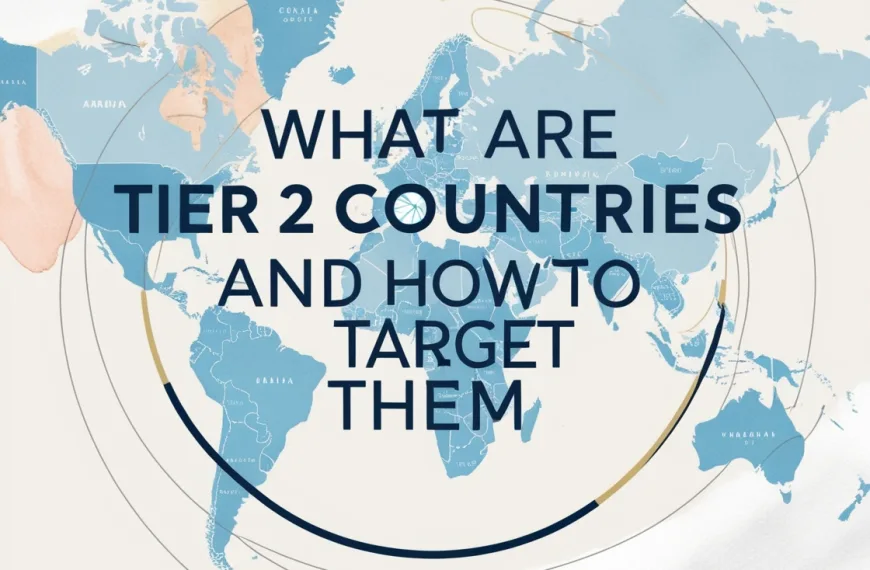In the ever-evolving world of international marketing, segmenting markets by tiers is a common practice used to better understand and approach different regions of the world. Among the most intriguing – and often misunderstood – segments are the Tier 3 countries. These markets can be challenging, unpredictable, and complex. But they also hold immense potential for growth, innovation, and long-term brand development. If you’re a marketer or business strategist looking to expand globally, Tier 3 countries might be more relevant to your plan than you think.
When people talk about global markets, you’ll often hear terms like Tier 1, Tier 2, and Tier 3 – especially in marketing and advertising. These labels are a kind of industry shorthand used to describe how developed a country’s economy, infrastructure, and digital landscape are. Tier 1 countries are the heavyweights – places like the US, UK, Germany, and Japan – where consumers have high purchasing power, stable internet access, and well-established markets. Tier 2 countries sit somewhere in the middle: they’re developing quickly, often have large populations, and can be great for scaling, but they may still face certain economic or infrastructural challenges. Then there are Tier 3 countries – typically less developed or emerging markets where conditions can be tougher but the potential is huge for businesses willing to put in the time and effort. These regions often get overlooked, but they’re full of opportunities if you approach them with the right mindset. Let’s take a closer look at what defines a Tier 3 country – and why it might be the smartest place for your next big move.
What Are Tier 3 Countries?
In marketing and advertising, countries are typically grouped into tiers (Tier 1, Tier 2, Tier 3) based on various factors such as economic development, consumer purchasing power, digital infrastructure, and ad market maturity.
Tier 3 countries are generally places where the economy is still developing or just starting to grow. They tend to have:
- Lower GDP per capita.
- Less mature digital and advertising infrastructures.
- Smaller average spend per user.
- Lack of fast internet or cutting-edge tech.
- Political or economic instability in some cases.
There’s no strict rule for what counts as Tier 3 – it can vary depending on the industry. A country might be seen as Tier 3 for one type of business, but Tier 2 for another. The classification also changes over time as markets evolve.
Examples of Tier 3 Countries
The list of Tier 3 countries is fluid, but generally includes many nations in Sub-Saharan Africa, parts of Southeast Asia, South Asia, the Middle East, and Latin America. Some examples might include:
- Nigeria.
- Kenya.
- Pakistan.
- Bangladesh.
- Nepal.
- Bolivia.
- Sudan.
- Myanmar.
- Ethiopia.
It’s important to note that being labeled Tier 3 doesn’t imply a lack of sophistication or capability. In many of these countries, there’s a young, tech-savvy population ready to engage – if the conditions are right.
Challenges in Tier 3 Markets
Entering Tier 3 countries can be daunting, and it’s essential to understand the hurdles of developing economies before diving in.
1. Infrastructure Limitations
Digital infrastructure, including access to mobile internet, payment systems, and logistics, can be less developed. For instance, mobile data might be expensive or slow, making it harder to deploy rich media ads or mobile-first strategies.
2. Limited Purchasing Power
The average consumer may have significantly lower disposable income compared to those in Tier 1 or Tier 2 markets. That means pricing, packaging, and even product design must be carefully tailored to local conditions.
3. Regulatory and Political Instability
Frequent changes in regulation, corruption, or political unrest can create an unpredictable business environment. Businesses must be flexible and prepared for rapid change.
4. Cultural Complexity and Language Barriers
Many Tier 3 countries have diverse populations with multiple languages and cultural nuances. Standardized marketing campaigns may not work, so localization is key.
5. Trust Issues and Brand Loyalty
In many low-income countries consumers are still skeptical of online services or unfamiliar international brands. Building trust takes time and often requires partnerships with local influencers or businesses.
Opportunities in Tier 3 Markets
Despite the challenges, Tier 3 countries can offer remarkable opportunities – especially for businesses that take the time to understand them.
1. First-Mover Advantage
In less saturated markets, there is room to become the go-to brand. Unlike Tier 1 countries, where competition is fierce, Tier 3 regions may still have gaps in offerings that you can fill.
2. Untapped Demographics
Many Tier 3 countries have large youth populations eager to engage with modern brands and technology. With mobile usage skyrocketing in these areas, digital-first strategies – even if scaled back – can be effective.
3. Cost-Effective Advertising
Advertising costs like CPC (cost per click) and CPM (cost per thousand views) tend to be much lower in Tier 3 markets, which means you can get a lot more value from your Tier 3 countries marketing budget.
4. Innovation and Adaptation
Necessity drives innovation. In Tier 3 countries, you might discover new consumer behaviors or business models that are not only applicable locally but can also be exported globally.
5. Long-Term Growth Potential
As infrastructure improves and economies grow, today’s Tier 3 countries could become tomorrow’s Tier 2 or even Tier 1. Establishing a presence early can set your brand up for long-term success.
Why You Should Consider Tier 3 Countries for Business
If you’re aiming for international growth, Tier 3 countries deserve a spot on your radar for several compelling reasons:
- Scalability. Entering multiple smaller markets can collectively drive significant growth.
- Market Diversification. Reduces dependence on saturated Tier 1 markets.
- Brand Positioning. Being seen as a pioneer can improve global brand perception.
- Social Impact. Serving underdeveloped markets can align with corporate social responsibility goals.
The key is to enter these markets with respect, local insight, and patience. Businesses that simply copy-paste strategies from the U.S. or Europe often fail. Success comes to those who listen, adapt, and build local relevance.
Tips for Dealing with Tier 3 Markets
When you’re ready to explore the potential of Tier 3 markets, the key is to take a thoughtful, flexible, and locally driven approach. It starts with research – not just the usual demographics, but a deep understanding of the culture, consumer habits, regulations, and competitive landscape. This often means working closely with local research firms or consultants who know the lay of the land far better than any outsider could.
Once you have that groundwork, resist the urge to dive in headfirst. Instead, start small. Roll out a pilot version of your product or service in a limited area, observe how people use it, and be open to adapting based on what you learn. It’s far better to make those adjustments early than to invest heavily in something that doesn’t quite fit.
Technology should match the realities on the ground. In many Tier 3 countries, mobile-first isn’t just a nice-to-have – it’s essential. You’ll likely get better results from lightweight apps, progressive web apps, SMS-based campaigns, and straightforward interfaces than from feature-heavy platforms designed for high-speed internet.
Building trust quickly is crucial, and one of the best ways to do that is through partnerships. Whether it’s local influencers who already have their audience’s ear or established businesses that understand how to navigate regulations and reach communities, these relationships can make a huge difference. They don’t just open doors – they help you avoid missteps.
When it comes to payments and logistics, flexibility is everything. Not every customer is using credit cards or expecting next-day delivery. In many Tier 3 areas, mobile wallets, cash on delivery, and creative distribution methods are what work. Meet people where they are, not where your standard model operates.
Equally important is cultural sensitivity What clicks with customers in one country might totally miss the mark somewhere else – or even cause offense. Something as simple as a poor translation, an awkward reference, or choosing the wrong color can turn people off and hurt how they see your brand. Take the time to localize your content properly and ensure it resonates.
Finally, be patient. These markets are not typically about quick wins. Building a presence and a loyal customer base may take time, and returns might come slower than in more developed regions. But if you’re willing to take a thoughtful, long-term approach, Tier 3 markets can open the door to steady growth and some surprising opportunities that make the effort more than worthwhile.
Conclusion
Tier 3 countries might not be the obvious choice for your next international campaign, but maybe they should be. With a careful, respectful, and informed approach, these markets offer rich rewards, unique insights, and a chance to build a lasting presence where few others have dared to go.
The future of global growth isn’t limited to developed economies. Sometimes, the most valuable opportunities lie where the world isn’t yet looking, and targeting Tier 3 countries is a perfect start.








